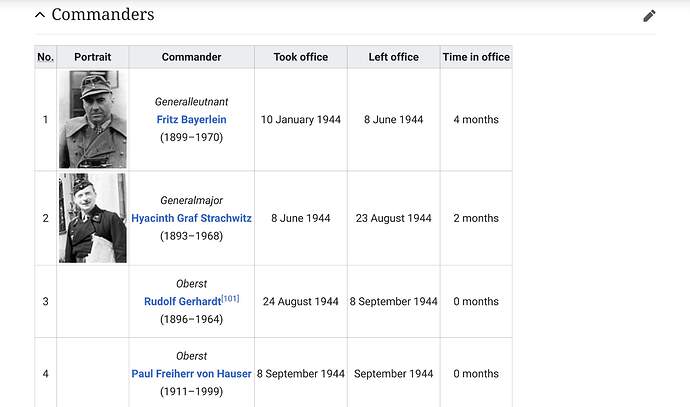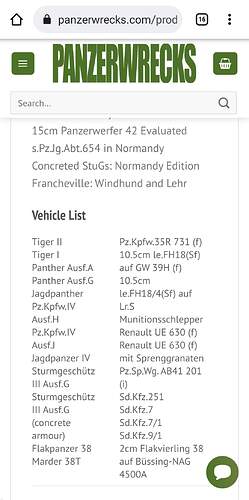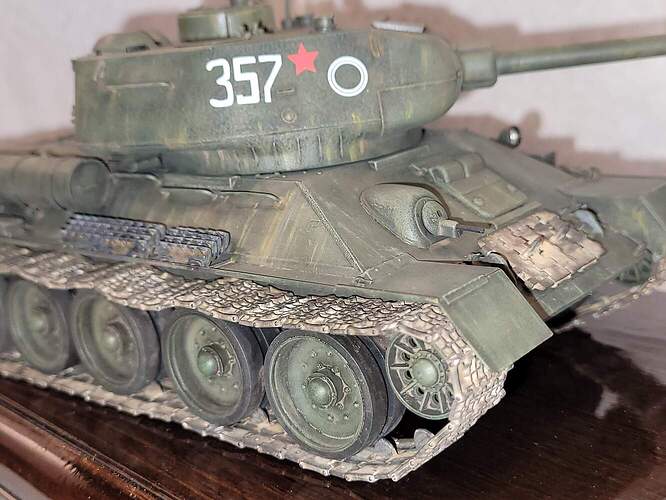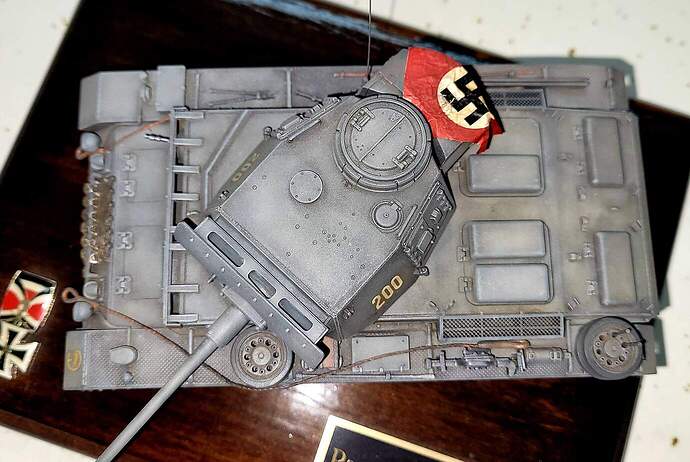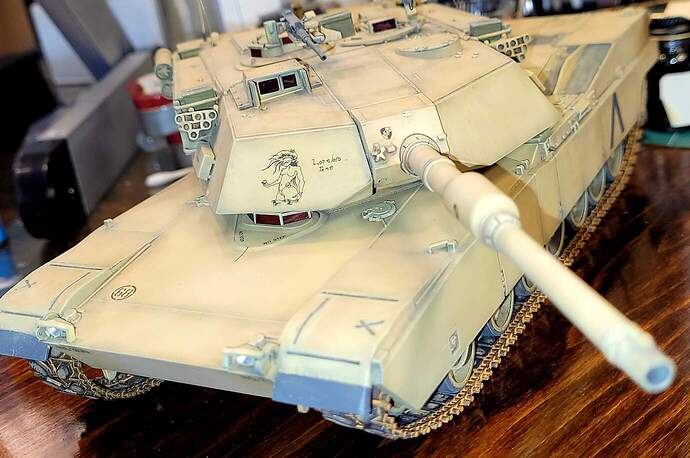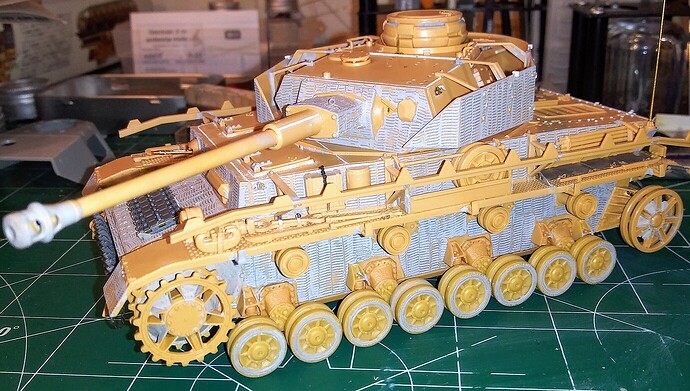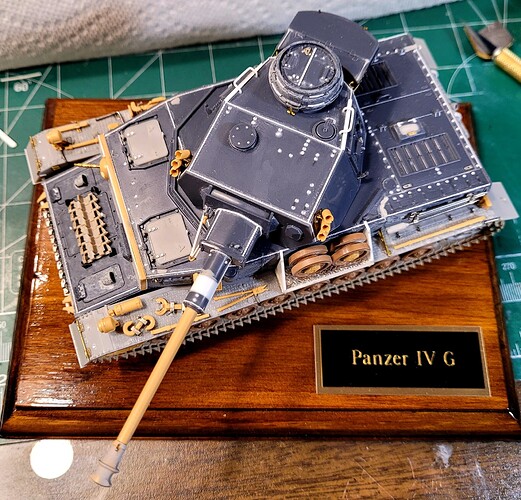I have started a study for my new project, the Italeri Jagdpanther with Winter Crew.
And there were three marking options, one of the Panzer Lehr Division and two of ‘unknown units’ which looked practically the same or just with a white wash of winter camouflage over the original camouflage scheme.
I decided to start with a study first of all of the Panzer Lehr division, because you need to start somewhere.
However, I’m not sure on how to do this exactly.
Because I don’t really have the money to spend on books for it, mostly because of the fact that I will end up with other expenses that needs money for them as well.
And besides that, I think the internet is a great place to start if you want the bigger things and less fine details known about a subject.
How would you use this Wikipedia article for example?
And in particular, the parts I have made screenshots of.
Because, I know how to read the text, or at least I think so.
But I’m not sure on what to do with the rest.
To start… get rid of wikipedia.
Lexicon.der-Wehrmacht.de is a good source.
Lexikon der Wehrmacht - PanzerdivisionenPanzer Lehr Division
Thank you for your reply.
Although, I can’t read or understand German.
I probably figure a way out of reading it and getting the information out of the source of information.
Hopefully I have bookmarked the links correctly, since I’m on my tablet.
And I’m not really familiair with Firefox on my tablet just yet.
And I have just synced my computer Firefox browser to my tablet Firefox .
Let’s just say, I hope I have done things correctly and that I’m able to read the information you gave me.
Thanks for information.
The following is from the History of War site:
Officially known as the 130th Panzer Division but more commonly known as Panzer Lehr, the division started forming up in late December 1943 in Wehrkreis (Military District) III but later transferred to the Nancy-Verdun-Luneville area of France in January 1944. As the title ‘Lehr’ (teach) indicates, this was intended to be an elite unit and at the suggestion of Generalinspekteur der Panzertruppe Generaloberst Heinz Guderian, was built around a cadre of personnel from both Panzertruppenschule I and II, many of whom had already seen combat on the Eastern Front, North Africa, Sicily and Italy, as well as elements of the 137th Infantry Division. Under Guderian’s patronage, the division was fitted out with some of the best equipment available, including a full complement of the superb PzKw V ‘Panther’ tanks. He also saw to it that command was given to one of his most trusted subordinates, Generalleutnant Fritz Bayerlein who had served under Rommel in North Africa. In addition and more unusually, the division was fully motorised with all its Panzergrenadiers being transported by armoured halftracks, rather than the usual mix of halftracks and trucks.
Operational History
The division’s first operational posting was to Hungary in Operation Margarethe (March – April 1944), where it absorbed the 901st Panzergrenadier Lehr Regiment, before moving back to France to await the Allied invasion. On D-Day itself, the division was near Paris under the control of the I SS Panzer Corps as part of the OKW (Oberkommando der Wehrmacht – High Command of the German Armed Forces) armoured reserve. The division was immediately ordered forward but in doing so, suffered delays and equipment losses (mainly soft-skinned vehicles) due to the Allied air superiority over Normandy. Entering the line next to the 12th SS Panzer Division ‘Hitlerjugend’ near Caen, it fought several British and Canadian attacks to a standstill, even managing (with elements of the 2nd Panzer Division and 101st SS Heavy Panzer Battalion) to retake the village of Villiers-Bocage in a counterattack after it was captured by the British 22nd Armoured Brigade. This battle also saw the famous action by panzer ace SS Obersturmführer Michael Wittman.
The division was then relieved by the 276th Infantry Division and on 7 July transferred to the LXXXIV Corps opposite US forces as they prepared to breakout as part of Operation Cobra, which was launched on 25 July. It was immediately preceded by an aerial bombardment from 1,500 Allied bombers and although this caused a lot of disruption and badly hit morale, there is still debate as to the actual number of casualties and equipment losses this caused. Nevertheless, despite suffering from both personnel and equipment attrition, the division managed to hold the advance of the entire US VII Corps to less than two miles on the 25 July. By the beginning of August, the division was down to around 11,018 personnel and thirty-three operational tanks and assault guns, with another forty-four under repair but following the encirclement of German forces at Falaise, the division was split into three kampfgruppen (battlegroups) who fought their way out to re-join German forces retreating eastwards, eventually reuniting at Senlis. It then retreated into the West Wall covering Bitburg, took part in the early battles for the Siegfried Line in Luxembourg with the LXXXI Corps before withdrawing to the Saar region and then Paderborn to be rebuilt and refitted under Sixth Panzer Army. It was then transferred to the First Army and helped prevent the collapse of Army Group G in November 1944 by counterattacking US forces advancing on the Saverne Gap.
The division was then placed under the control of the XXXXVII Panzer Corps, part of the Fifth Panzer Army under General der Panzertruppen Hasso von Manteuffel which was due to take part in Operation Wacht am Rhein, more commonly known as the ‘Battle of the Bulge’. However, the premature commitment of several units (including Panzer Lehr) in order to stem the advance of US forces just weeks before, led to the operation being postponed while the units involved were brought back up to strength. Even so, Panzer Lehr was still understrength (twenty-seven PzKw IV, thirty Panthers and twenty Jagdpanzer IV/70s) by the time the operation commenced on 16 December and so was reinforced by two tank destroyer battalions and an assault gun brigade. The 26th Volksgrenadier Division was meant to clear the way for the division but became bogged down. Panzer Lehr, which had been part of the Fifth Panzer Army’s reserve (along with the Führer Begleit Brigade), entered the line where it besieged Bastogne (held by the US 101st Airborne Division) but could not take the town. When the offensive failed, the division relocated to the Netherlands and fought in the Battle for the Maas Line and then moved south to try to eliminate the American bridgehead at Remagen in early March 1945. By this time the division was merely a burnt out shell of its former self, being only a large battalion battlegroup in size. It then retreated into the Ruhr Pocket, surrendering to the US 99th Infantry Division on 15 April 1945.
Commanders
December 1943 – January 1944 Generalmajor Oswin Grolig
January – June 1944 Generalleutnant Fritz Bayerlein
June-August 1944 Generalmajor Hyacinth Graf Strachwitz
August – September 1944 Oberst Rudolf Gerhardt
September 1944 Oberst Paul Freiherr von Hauser
September 1944 – January 1945 Generalleutnant Fritz Bayerlein
January 1945 Oberstleutnant Kurt Kauffmann
January – April 1945 Generalmajor Horst Niemack
April 1945 Oberst Paul Freiherr von Hauser
Order of Battle
Component Units:
130th Panzer Lehr Regiment
901st Panzer Grenadier Lehr Regiment
902nd Panzer Grenadier Lehr Regiment
130th Panzer Artillery Regiment
130th Panzer Lehr Reconnaissance Battalion
130th Panzer Lehr Tank Destroyer Battalion
130th Panzer Pioneer Battalion
130th Panzer Signals Battalion
311th Army Flak Battalion
130th Divisional Support Unit
1st June 1944
Having yet to be committed to battle, on the eve of Operation Overlord (D-Day) the division was nearly at full strength, with a couple of sub-units on their way back to Normandy.
Personnel: 14,699
Equipment: 103 x PzKw IV, 79 x Panther, 31 x Jagdpanzer IV, 12 x Flak Panzer, 4 x Berge Panzer, 85 x Light APCs, 590 x Medium APCs, 26 x Armoured Cars, 12 x SPGs, 6 x Hummel and 12 x Wespe self-propelled guns (SPGs).
3rd September 1944
The losses suffered in Normandy (especially in equipment) meant that the division would never again reach the overall combat strength it had on the eve of Operation Overlord. By early September (shortly before Operation Market Garden) the division was so depleted in equipment that it could barely mount defensive operations. To make things worse, the 130th Panzer Regiment’s 1st Battalion was on detached duty with the 113th Panzer Brigade for much of September.
Personnel: 11,969
Equipment: 11 x PzKw IV (with another nine in various states of repair), 6 x Panthers (with another seven in various states of repair), 11 x Light APCs, 46 x Medium APCs (with another twenty-one in various states of repair), 4 x Armoured Cars (with another one under repair).
1st November 1944
Following Operation Market Garden and the continued Allied advance into the Low Countries and Eastern France, the division spent late October and early November refitting and re-equipping.
Personnel: 12,660
Equipment: 28 x PzKw IV, 16 x Panther, 2 x Berge Panzers, 21 x Light APCs (with another eleven in various states of repair), 23 x Medium APCs (with another forty-six in various states of repair), 6 x Armoured cars (with another one under repair), 7 x SPGs (with another one under repair).
Special Insignia and Uniforms
The only special insignia associated with this division is the letter ‘L’ (for Lehr) which was worn on the shoulder straps of all the division’s personnel. It was embroidered in the appropriate Waffenfarbe for junior ranks, stamped in white metal for senior NCOs and in guilt metal for officers. In addition, instead of the standard uniforms worn by the rest of the Heer’s infantry such as the M1943 pattern, most of the division’s Panzergrenadiers wore short, grey double-breasted tunics and lace-up boots, similar to the uniforms worn by the Sturmgeschütze crews. The divisional motif on its vehicles was a white, stylised ‘L’.
Wargaming Panzer Lehr
Several wargames figure manufacturers, such as Black Tree Design, Crusader Miniatures, Artizan Design, Rubicon Models and Warlord Games (as part of their Bolt Action series), do an extensive range of both 28mm figures and equipment covering the German Army during the late war period of 1944 to 1945. These are available both as individual figures, vehicles or pieces of equipment (such as an anti-tank gun or artillery piece) but also in larger units, including sets that are ‘themed’ (such as Warlord Games’ German Offensive Force (Winter) or the German Grenadiers Starter Army). Both Warlord and Rubicon have most if not all the major items of equipment that Panzer Lehr utilised, including PzKw IV Ausf. F1 / G / H tanks, Panther Ausf. D and G tanks, Jagdpanzer IV/48 and IV/70 tank destroyers, StuG III Ausf. G self-propelled gun, Hummel SPG, Wespe SPG, SdKfz 234 armoured cars, SdKfz 251 Ausf. C and 251/1 Ausf. D halftracks. It is also worth noting, that while the majority of German infantry figures will be in the late war M1943 or M1944 pattern uniforms (as well as many having camouflage smocks or using their zeltbahn tent quarters as camouflage capes – see for example Warlord Games’ Veteran Grenadiers Squad or German Grenadiers box set), Artizan Designs actually produce a set of figures wearing the double-breasted tunic and lace-up boots entitled ‘SWWB01 Panzer Lehr Grenadier Squad’, which can be found here: SWWB01 - Panzer Lehr Grenadier Squad - Artizan Designs.
Bibliography
Bellis, M. (1988) German Tanks and Formations 1939-45, Crewe: Self-Published.
Dugdale, J (2000) Panzer Divisions, Panzergrenadier Divisions, Panzer Brigades of the Army and the Waffen SS in the West, Autumn 1944 – February 1945: Ardennes and Nordwind – Their Detailed and Precise Strengths and Organisations, Volume I, Part 1 (September 1944 Refitting and Re-Equipment), Milton Keynes: The Military Press.
Dugdale, J (2001) Panzer Divisions, Panzergrenadier Divisions, Panzer Brigades of the Army and the Waffen SS in the West, Autumn 1944 – February 1945: Ardennes and Nordwind – Their Detailed and Precise Strengths and Organisations, Volume I, Part 3 (November 1944 Refitting and Re-Equipment), Milton Keynes: The Military Press.
Mitcham, S. (2001) The Panzer Legions: A Guide to the German Army Tank Divisions of World War II and Their Commanders, London: Greenwood Press.
Nafziger, G. (2011) Organizational History of the German Armoured Formations 1939-1945, Combined Arms Research Library (Digital Library), archived from the original 8 December 2011, located at https://web.archive.org/web/20111208094147/http://www.cgsc.edu/CARL/nafziger/939GXPZ.PDF, as of 17 July 2018.
Wikipedia. (2018) Panzer Lehr Division webpage, last updated 16 April 2018, located at Panzer Lehr Division - Wikipedia, as of 17 July 2018.
Williamson, G. (2002) German Army Elite Units 1939-45, Oxford: Osprey Publishing, Men-at-Arms Series No. 380.
Zetterling, N. (2000) ‘Panzer-Lehr Division’ webpage, from the German Military Organization, Combat Power and Organizational Effectiveness website, archived from the original on 16 July 2008 at https://web.archive.org/web/20080716060215/http://web.telia.com/~u18313395/normandy/gerob/pzdiv/lehr.html, as of 19 July 2018.
Author: Peter D Antill, CFDA, Cranfield University, Defence Academy of the UK
Thank you for this rich source of information, I have read most of it.
And I think I will use it for some further study for my subject.
Or to get other ‘clues’ to study to subject in more depth.
And to get other study subjects as well and see connections between subjects and such.
Look, as a classically trained military historian I’d give you this advice you need to better define what you want to research. TWhat are you trying to learn or accomplish, when it comes to modeling most guys research with a goal in mind to make a more accurate kit detail wise or maybe verify a camo pattern or vehicle number. So depending on what you are after will determine the chase. Your question, to me, is like saying “I want to learn to swim, should I try an ocean crossing first or a channel swim?” When you actually just need a regular pool.
I don’t really know, I just don’t know what there is to research for my project.
What I had in mind was that I wanted to know combat history of the specific vehicle and verify
at the same time if that vehicle really fought with the specified division.
I also would like to find actual pictures of the vehicle, to verify if everything is correct.
Don’t really know much more.
The Panzerwrecks book series has a good bit of that sort of that information.

You’ll have to sort thru the descriptions of the 23 volumes to find which ones have Panzer Lehr vehicles.
Volumes #17 has some Lehr info and pictures etc as shown below. I just flipped through my copy of #17 and his has excellent Lehr pics of a 251 half-track, Pz IV, Lehr Panther on pages #3-7
Example of pics of Jagdpanther from s.Pz.Jg.Abt. 654
For discussion only.
I know you say you can’t afford many books, but I would recommend Dennis Oliver’s “Jagdpanther Tank Destroyer, German Army and Waffen SS Western Europe 1944-1945”, part of the Tankcraft series. The cover price is £14.99, but I’m sure it’s available cheaper on Amazon or Abebooks. I certainly didn’t pay full cover price for my copy. It includes a short section on Panzer Lehr, specifically this unit’s use of the Jagdpanther. This range of books always includes a colour section with numerous marking and painting schemes, a section on detail differences with the featured vehicle and a modelling section listing after market parts available. I feel this would cover the subject vehicle and unit you are interested in adequately for your needs. You need to be aware that many of the schemes on kit instructions are suspect, if not spurious. I don’t know what mark of Jagdpanther the Italaeri kit represents, G1 or G2. These have numerous detail external differences which are quite noticeable, kit manufacturers seem to go attractive schemes whether they fit the vehicle or not. But the book I’ve mentioned covers these detail differences. I suggest you obtain a copy before you reach the painting stage!
I haven’t started on the project, I have learned from previous mistakes I made.
And I concluded it is best to study before starting a project.
I’m also making notes and short notes to help me with researching and use other points to possibly get further into research.
It standed out to me that most of the divisions, including the Panzer Lehr had something to do with the D-Day landings.
Like the 17. SS Panzer Grenadier Divsion ‘Götz von Berlichingen’ they took part in the figtings around Caen.
And that is an example of a point on which I might want to study even further.
I still got plans to study this SS Division of which I build a Sturmgeschütz IV, but I just don’t get to that stage.
Unfortunately.
What would be a good general book store to buy books?
Because I’m now getting my books from Sprach- und Währungseinstellungen ändern, since the previous general webshop I bought them takes crazy amounts of time to deliver them.
Sometimes a month or so, which I’m not willing to wait for.
So that also is the reason why I think, maybe it is time to go to a good specialized book store where I can buy all the books I might want?
Thanks for replying and I will consider this.
I appreciate your reply and your book suggestion.
And what I’m getting from you is, that I should do a little digging through these sources you provided me.
Thank you for these pointers and I will try to use them.
Yes, suggesting a search through the information on the Panzerwrecks volumes to help find what your looking for. Not suggesting any specific Panzerwrecks volume.
BTW - Hohenstaufen mentioned a book that sounds very promising and worth checking out.
Well I’m completely ignorant on book stores where you live. For me in the states I browse at Barnes and Noble and Montana is ripe w used book stores. I recently picked up a 3rd Army Patton book which I couldn’t pass up. Many of the internet model sites will have reference sections to browse through., Books to purchase. I’m guessing you are in Europe and their is a wealth of archival collections and museums to take advantage. I was smart enough to have held on to my Squadron In Action collection so it gives me a basic start and some nice details shots that for my current abilities is just about right.
The thing is you really should narrow your focus, that will help narrow where to look for info but you are going to have to make the choice and put in the effort. That’s part of the journey, doing it yourself. But don’t get so caught up in research that you forget to build to have fun. One can argue “well I want the right colors or markings” but if you put it on a shoddy kit was it worth the effort? Don’t get hung up on a vehicle number or something and let the ‘research’ stop the build.
Hope this all makes sense.
That’s excellent advice on my opinion. I’ve seen several outstanding armor modelers get “trapped” doing research over down right trivial stuff and not get any models built literally for years.
From beginner to intermediate level building additional models, developing and improving modeling skills will pay a much greater dividend in improved results than “research”.
Honestly, research materials (books) and the spent time looking typically comes directly from the amount of normally limited hobby time available.
In the 1990’s, books are research were probably the least efficient use of my time and resources. My mid model Tiger 1 kit build that’s been stalled for 25 years due to “research” comes to mind ![]()
I’m not trying to be hard on this young man but if memory serves wasn’t he the one w a long discussion on the value of an Xacto knife no less? I’m just not sure w the info he’s been given what his intent is. A quick question on “did this unit use XYZ on this date” would suffice and be able to be answered quickly by many here. Hoping my hints will save him some time and frustration, KISS principle for your research.
I think the xacto debate was with someone else.
Thank you for replying.
It does make a lot of sense, that discovering things on my own is a critical part of the journey.
And I’m willing to do that, however, my resources are limited.
In the area where I live, they don’t have many book stores.
And things I want most of the time aren’t to be find in the place or area where I live.
The internet is all I have as a connecting factor with the other scale modelers out there in the world.
And purchasing things mainly happens online, because chances to buy things locally of things I’m wanting is just to small to take the ‘gamble’.
I’m going to do my best. And I’ve today started excercising again with my new Harder en Steenbeck evolution airbrush I bought at Airbrush Services Almere, but even that wasn’t easy.
We had to drive 45 minutes or more just to get such things.
Point is, I’m willing to do things and discover things by myself.
But I can only get so far if resources and knowledge are limited.
It makes sense to improve and practice my scale modeling skills.
But if I don’t have the knowledge, I don’t know what to do.
Luckily, I’m planning to buy books from Osprey Publishing to help me with learning the right skills.
To get the knowledge I need to actually do things.
Why buy books you may ask, because I’m trusting books more then the internet in these cases.
Because, I want to be sure I got the right info and that it actually is correct.
Definitely understand being skeptical of the internet information. Takes a fair amount of sifting to get the wheat from the chaff online.
I’ve mentioned this book many times in various threads as an outstanding cornerstone to getting started in the right direction.

Shepard Paine isn’t trying to sell a bunch of weathering products. He’s all about building quality models. This old book is still a fantastic first book.
Quality Basic Construction is very cut and dried very objective and concrete. Good models start with this. Nothing is less realistic than a model tank with mold seams, punch marks, misaligned parts and seams regardless of how well weathered it is in my opinion.
The experienced folks on this forum are generally very good at building models and can help a novice who is willing to accept suggestions and practice by building models. In less than a year, I’ve seen open minded modelers on this forum that actively build models go from novice skill level to intermediate skill level to advanced skill level. That’s pretty amazing and it speaks very well of the high quality information provided on this forum combined with motivation and hard work by those modelers.
If you see multiple examples of the quality work by modeler on this site or another site, that should be all the proof needed to show you that person actually knows what they are doing and talking about. That person’s style may not be exactly what you’re looking for but style is like opinion personal taste varies but one can still learn quiet a bit from others.
On that note, I’ll probably bow out of this discussion. I make no claim of being an expert but feel like I have a handle on the basics.
Happy modeling 
I can’t remember that discussion, probably someone else.

